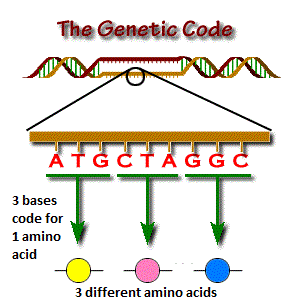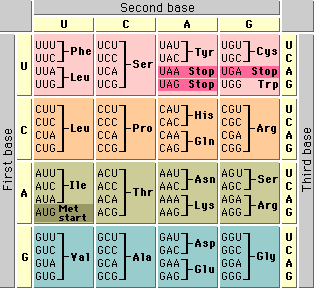What is Genetic Code | What is CodonGenetic code is a group or sequence of nucleotides (nitrogenous bases) in the DNA molecule. Genetic code in DNA provides instructions to produce mRNA or we can say that mRNA is formed from genetic code (sequence of nucleotides or DNA). The term 'genetic code' is given by George Gamow. 
The triple nitrogenous base sequence on mRNA (which is produced from DNA through transcription) is called a codon. Whereas, genetic code refers to sequences of triplet nitrogenous bases or the entire sequence of nitrogenous bases in a DNA segment. So, genetic code is the language of DNA. Codon will always be in triplet form as it is coding for a single amino acid. So, it is a triplet that is known as a codon. It is a set of instructions that directs the translation of DNA into amino acids, the monomers of proteins. As a codon is a group of three nucleotides, the four nucleotides can produce 64 different combinations or codons. Out of these, 61 codons code for amino acids and they are known as sense codon, whereas, the remaining 3 codons (UAA, UAG, UGA) represent stop signal for the end of protein synthesis. They are known as nonsense code or codon as they do not code for protein synthesis. Besides this, one codon code for the synthesis of only one specific amino acids, so, it cannot code for any other amino acid. However, there are some amino acids that are coded by more than one codon. The codon is read in mRNA in a continuous fashion, no gap between two codons. Also, the codes are non-overlapping, for example, in AUGUUU, there can be AUG, UUU, etc., but not UGU after AUG. So, the three nucleotides of AUG cannot become part of other codes or codons. The codon AUG performs dual functions; it acts as a starting codon or initiator and also codes for the synthesis of amino acid Methionine. However, only if it is present at the start of a transcription unit, it acts as a starting codon, but, if it is present in between it will code for Methionine. Some exceptions of Genetic Code:
How the genetic code discovered I Who discovered genetic codeIt was the George Gamow who for the first time in the 1950s realized that the genetic code was composed of groups or triplets of three nucleotides. He concluded that a group of three consecutive nucleotides of a gene might code for one amino acid in a polypeptide or protein. He tried to find out how 20 amino acids in the human body are synthesised by four nitrogenous bases. He made the different combination of nitrogenous bases to understand how many nitrogenous bases could be working as a group to code for a single amino acid. For example, he said that if one nitrogenous base is synthesizing one amino acid then it can give us only four amino acids but we have 20 amino acids. Similarly, he found that there would be a total number of 16 groups or combination of nitrogenous bases if groups of two nucleotides or nitrogenous bases are made out of four available bases. He found that even a doublet code (a group of two nucleotides) for an amino acid would not work as only 16 ordered groups of doublet code or groups of nucleotides could be formed that is too few to code for the synthesis of 20 amino acids. Next, he chose made group or combination of three nitrogen bases and found that a code made of a group of three nucleotides seemed appropriate as it would make 64 unique groups of three nucleotides or triplets (4x4x4) that would be sufficient to code for the synthesis of 20 amino acids. So, Gamow concluded that genetic code or nitrogenous bases that form codon exits in the form of a triplet (a group of 3 nitrogenous bases). And, each triplet forms an amino acid. Gamow's triplet hypothesis was widely accepted. However, it was not clear that which triplet of nucleotide code for which amino acid. Later, the progress in the understanding of genetic code began in 1961 with the work of the American biochemist Marshall Nirenberg. He along with his team was able to identify specific nucleotide triplets that correspond to specific amino acids. They were able to reach this conclusion through the two following experimental innovations.
For example, Nirenberg made an mRNA molecule containing only Uracil nucleotide (poly-U). Then he added this mRNA to the cell-free system. He found that all the polypeptides made by this mRNA are made of only one amino acid, which was phenylalanine. There was only one triplet in this mRNA, which was UUU, so he concluded that UUU might have coded for phenylalanine. Similarly, he also proved that poly-C mRNA was decoded into polypeptides made of amino acid proline that suggested that the triplet CCC may code for proline. Later, Har Gobind Khorana, a biochemist, synthesized artificial mRNA with more complex sequences. For example, he generated a poly-UC ( UCUCUCUC….) mRNA and added it into a cell-free system. Now as per the triplet code rule, this poly-UC will give two combinations of triplet codon which are CUC and UCU. This mRNA made polypeptides with an alternating arrangement of serine and leucine amino acids. CUC formed leucine and UCU formed serine. This experiment, like other experiments, also confirmed that the genetic code is a triplet. Accordingly, as of now, codon UCU codes for serine and codon CUC codes for leucine. Later by 1965, Nirenberg, Khorana and their team members successfully deciphered the whole genetic code and came up with a genetic code table with all the 64 possible combinations of bases or 64 codons. Types of codons:1. Sense codons The codons that code for the amino acid synthesis are called sense codons. There are 61 sense codons as there are 61 codons that code for 20 amino acids. 2. Signal Codons They code for signals such as start and stop signals during protein synthesis. There are four signal codons that include AUG, UAA, UAG and UGA. They can be of following two types: i) Start codons: As the name suggests, this codon starts the translation process. It is the first codon of a messenger RNA that marks the site at which translation starts. It is also known as the initiation codon as it initiates the synthesis of the polypeptide chain. For example, AUG is a start codon, however, it also codes for the methionine amino acid. ii) Stop codons: It is located within the mRNA. It is required to stop the translation or synthesis of the polypeptide chain. They give the signal for the termination of the polypeptide chain, so they are also called termination codon. For example, UAA, UAG and UGA are stop codons. Formerly, they are known as non-sense codons as they don't code for any amino acids. The signals given by stop codons are not read by transfer RNA (tRNA). They are read by proteins, which are known as release factors. In prokaryotic organisms or prokaryotic cells, the release factors are RF1, RF2 and RF3. RF1 recognizes the stop signals of UAA and UAG, whereas, RF2 catches the signals of UAA and UGA. However, the RF3 activates RF1 and RF2. Whereas, in eukaryotes, there is only one release factor (eRF1) that recognizes all of the three stop codons. Properties of Genetic Code:
Functions of genetic code:
Next TopicProtein Synthesis
|
 For Videos Join Our Youtube Channel: Join Now
For Videos Join Our Youtube Channel: Join Now
Feedback
- Send your Feedback to [email protected]
Help Others, Please Share









